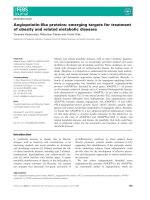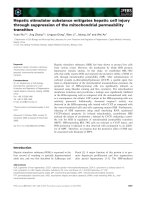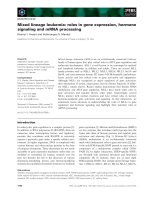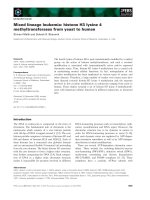Tài liệu Báo cáo khoa học: "Toward finer-grained sentiment identification in product reviews through linguistic and ontological analyses" ppt
Bạn đang xem bản rút gọn của tài liệu. Xem và tải ngay bản đầy đủ của tài liệu tại đây (118.39 KB, 4 trang )
Proceedings of the ACL-IJCNLP 2009 Conference Short Papers, pages 169–172,
Suntec, Singapore, 4 August 2009.
c
2009 ACL and AFNLP
Toward finer-grained sentiment identification in product reviews
through linguistic and ontological analyses
Hye-Jin Min
Computer Science Department
KAIST, Daejeon, KOREA
Jong C. Park
Computer Science Department
KAIST, Daejeon, KOREA
Abstract
We propose categories of finer-grained polari-
ty for a more effective aspect-based sentiment
summary, and describe linguistic and ontolog-
ical clues that may affect such fine-grained po-
larity. We argue that relevance for satisfaction,
contrastive weight clues, and certain adver-
bials work to affect the polarity, as evidenced
by the statistical analysis.
1 Introduction
Sentiment analysis have been widely conducted
in several domains such as movie reviews, prod-
uct reviews, news and blog reviews (Pang et al.,
2002; Turney, 2002). The unit of the sentiment
varies from a document level to a sentence level
to a phrase-level, where a more fine-grained ap-
proach has been receiving more attention for its
accuracy. Sentiment analysis on product reviews
identifies or summarizes sentiment from reviews
by extracting relevant opinions about certain
attributes of products such as their parts, or prop-
erties (Hu and Liu, 2004; Popescu and Etzioni,
2005). Aspect-based sentiment analysis summa-
rizes sentiments with diverse attributes, so that
customers may have to look more closely into
analyzed sentiments (
Titov and McDonald,
2008). However, there are additional problems.
First, it is rather hard to choose the right level
of detail. If concepts corresponding to attributes
are too general, the level of detail may not be so
much finer than the ones on a document level.
On the other hand, if concepts are too specific,
there may be some attributes that are hardly men-
tioned in the reviews, resulting in the data
sparseness problem. Second, there are cases
when some crucial information is lost. For ex-
ample, suppose that two product attributes are
mentioned in a sentence with a coordinated or
subordinated structure. In this case, the informa-
tion about their relation may not be shown in the
summary if they are classified into different up-
per-level attributes. Consider (1).
(1) a. 옷은 맞지만/맞긴 한데, 색상이 너무
어두워요. osun macciman
, sayksangi nemwu
etwuweyo. ‘It fits me okay, but
the color is too
dark.’ (size: barely positive, color: negative)
b. 생각보다 좀 얇지만
, 안에 받쳐 입는
거니까 나름 괜찮은거 같아요. sayngkakpota
com yalpciman, aney patchye ipnun kenikka
nalum kwaynchanhunke kathayo. ‘It’s a bit
thinner than I thought, but it is good enough
for layering.’ (thickness: negative but accepta-
ble, overall: positive)
Example (1) shows sample customer reviews
about clothes, each first in Korean, followed by a
Yale Romanized form, and an English translation.
Note that the weight of the polarity in the senti-
ment about size e.g. in (1a) is overcome by the
one about color. However, if the overall senti-
ment is computed by considering only the num-
ber of semantically identical phrases in the re-
views, it misses the big picture.
In particular, when opinions regarding
attributes are described with respect to expres-
sions whose polarities are dependent on the spe-
cific contexts such as the weather or user prefe-
rence, an overestimated or underestimated
weight of the sentiment for each attribute may be
assigned. In our example, 얇다/
yalpta/‘thin’ has
an ambiguous polarity, i.e., either positive or
negative, whose real value depends on the ex-
pected utility of the clothes. In this case, the neg-
ative polarity is the intended one, as shown in
(1b). In order to reflect this possibility, we need
to adjust the weight of each polarity accordingly.
In this paper, we propose to look into the kind
of linguistic and ontological clues that may in-
169
fluence the use of polarities, or the relevance for
‘satisfaction of purchase’ inspired by Kano’s
theory of quality element classification (Huisko-
nen and Pirttila, 1998), the conceptual granulari-
ties, and such syntactic and lexical clues as con-
junction items and adverbs. They may play sig-
nificant roles in putting together the identified
polarity information, so as to assess correctly
what the customers consider most important. We
conducted several one-way Analysis of Variance
(ANOVA) tests to identify the effects of each
clue on deriving categories of polarity and quan-
tification method 2 to see whether these clues
can distinguish fine-grained polarities correctly.
Section 2 introduces categories of polarity.
Section 3 analyzes ontological and linguistic
clues for identifying the proper category. Section
4 describes our method to extract such clues for a
statistical analysis. Section 5 discusses the results
of the analysis and implications of the results.
Section 6 concludes the paper.
2 Categories of polarity
We suggest two more fine-grained categories of
polarity, or ‘barely positive’ (BP) and ‘accepta-
bly negative’ (AN), in addition to positive (P),
negative (N) and neutral (NEU). We distinguish
‘barely positive’ from normal positive and dis-
tinguish ‘acceptably negative’ from normal nega-
tive in order to derive finer-grained sentiments.
Wilson and colleagues (2006) identified the
strength of news articles in the MPQA corpus,
where they separated intensity (low, medium,
high) from categories (private states). For the
purpose of identifying each attribute’s contribu-
tion to the satisfaction after purchase, we believe
that it is not necessary to have so many degrees
of intensity. We argue that the polarity of ‘barely
positive’ may hold attributes that must be satis-
fied and that ‘acceptably negative’ may hold
those that are somewhat optional.
3 Linguistic and Ontological Analyses
In this section, we discuss linguistic and ontolog-
ical clues that influence the process of identify-
ing finer-grained polarity. For the purpose of ex-
position, we build hierarchical and aspect-based
review structure as shown in Figure 1. Major
aspects include Price, Delivery, Service, and
Product. If we go down another level, Product is
divided into Quality and Comfortableness. In
defining relevant attributes, we consider all the
lower-level concepts of major aspects, which
contain the characteristics of the product with a
description of the associated sentiment.
Figure 1. Review structure
Relevance for Satisfaction: We consider re-
levant attributes that affect the quality and satis-
faction of the products as one of the important
clues. Quality elements classified by Kano as
shown in Table 1 can be base indicators of rele-
vant attributes for satisfaction in real review text.
For example, while completeness of the product
may become crucial if the product has a defect, it
is usually not the case that it would contribute
much to the overall satisfaction of the customer.
Quality Elements Example features
Must-be Quality (MQ) Durability, Completeness
1-dimension Quality (1DQ) Design, Color, Material
Attractive Quality (AQ) Luxurious look
Table 1. Kano's Quality Elements
Conceptual Granularity: The concepts cor-
responding to attributes have a different level of
detail. If the customer wants to comment on
some attributes in detail, she could use a fine-
grained concept (e.g., the width of the thigh part
of the pants) rather than a coarse-grained one
(e.g., just the size of the pants). To deal properly
with the changing granularity of such concepts,
we constructed a domain specific semi-
hierarchical network for clothes of the Clothing-
Type structure, in addition to the Review struc-
ture, by utilizing hierarchical category informa-
tion in online shopping malls. Figure 2 shows an
example for “pants”.
ClothingType
Bottom
Pants
Sub_f
Sub_p
Thigh
CalfWaistHip
Length+
Material+
Design:
Line+
Design:
Pattern*
Design:
Style*
Color
Size
Design:
Detail*
Figure 2. ClothingType structure for pants
Syntactic and Lexical Clues: Descriptions of
each attribute in the reviews are often expressed
170
in a phrase or clause, so that conjunctions, or
endings of a word with a conjunctive marker in
Korean, play a significant role in connecting one
attribute to another. They also convey a subtle
meaning of the sentiment about relations be-
tween two or more connected attributes. We
classified such syntactic clues into 4 groups of
likeness (L), contrary (C), cause-effect (CE), and
contrary with contrastive markers (CC).
Wilson and colleagues (2006) selected some
syntactic clues as features for intensity classifica-
tion. The selected features are shown to improve
the accuracy, but the set of clues may vary to the
nature of the given corpus, so that some other-
wise useful clues that reflect a particular focused
structure may not be selected. We argue that
some syntactic clues such as the use of certain
conjunctions can be identified manually to make
up for the limitation of feature selection.
Adverbs modifying adjectives or verbs such as
too, and very also strengthen the polarity of a
given sentiment, so such clues work to differen-
tiate normal positive or negative from ‘barely
positive’ and ‘acceptably negative’. Table 2
summarizes linguistic clues in the present analy-
sis.
Clues Examples
CONJ/
END
L
-고 -ko ‘and’
C
-지만 -ciman ‘but’,
그러나 kulena ‘however’
CE
-어서 -ese ‘so’, 그래서
kulayse ‘therefore’
CC
-긴 –지만 -kin -ciman ‘It’s
…, ‘but’, ‘though’
ADV Strong
매우 maywu ‘very’,
너무 nemwu ‘too’
Mild
좀 com ‘a little’
Table 2. Syntactic and Lexical Clues
All these three types of clue that appear in the
review text may interact with one another. For
example, attributes with ‘barely positive’ tend to
be described with a concept on a coarse level,
and may belong to Must-be Quality (e,g., size in
(1a)). However, if such attributes are negative,
customers may explain them with a very fine-
grained concept (e.g., the width of thigh is okay,
but the calf part is too wide; interaction between
relevance for satisfaction and conceptual granu-
larity). They may also use adverbs such as ‘too’
to emphasize such unexpected polarity informa-
tion. For emphasis, a contrastive structure can be
used to indicate which attribute has a more
weight (e.g., ‘A but B’; interaction between syn-
tactic clues and relevance for satisfaction). In
addition, an unfocused attribute A may be the
attribute with ‘acceptably negative’ if the polari-
ty of the attribute B is positive. We believe that
the interaction between lexical and syntactic
clues and relevance for satisfaction are the most
important and that this correlation information
may be utilized with such fine-grained polarity
as ‘barely positive’ or ‘acceptably negative’.
4 Clue Acquisition
We acquired data semi-automatically for each
clue from the extracted attributes and their de-
scriptions from 500 product reviews of several
types of pants and annotated polarities manually.
We obtained raw text reviews from one of the
major online shopping malls in Korea
1
and per-
formed a morphology analysis and POS-tagging.
After POS-tagging, we collected all the noun
phrases as candidates of attributes. We regarded
some of them as attributes with the following
guidelines and filtered out the rest: 1) NP with
frequent adjectives 2) NP with frequent non-
functional and intransitive verbs. In the case of
subject omission, we converted adjectives or
verbs into their corresponding nouns, such as
‘thin’ into ‘thickness’. Hu and Liu (2004) identi-
fied attributes of IT products based on frequent
noun phrases and Popescu and Etzioni (2005)
utilized PMI values between product class (ho-
tels and scanners) and some phrases including
product. In our case, we used attributes that be-
long only to the Product concept in the Review
structure, because most attributes we consider
are sub-types or sub-attribute of Product. The
total number of <attribute, polarity> pairs is 474.
For relevance for satisfaction, we converted
extracted attributes into one of the types of Ka-
no’s quality elements by the mapping table we
built. For conceptual granularity we regarded all
the attributes with a depth less than 2 as ‘coarse’
and those more than 2 as ‘fine’. Syntactic and
lexical clues are identified from the context in-
formation around extracted adjective or verbs by
the patterns based on POS information.
5 Statistical Analysis and Discussion
We conducted one-way Analysis of Variance
(ANOVA) tests using relevance for satisfaction
(ReV), conceptual granularity (Granul), and two
linguistic clues, ADV and CONJ/END, in order
to assess the effects of each clue on identifying
categories of polarity. The ANOVA suggests
1
171
reliable effects of ReV (F(2,474) = 22.2; p
= .000), ADV (F(2, 474) = 41.3; p = .000), and
CONJ/END (F(3, 474) = 6.1; p = .000). We also
performed post-hoc tests to test significant dif-
ferences. For ReV, there are significant differ-
ences between ‘MQ’ and ‘1DQ’ (p=.000), and
between ‘MQ’ and ‘AQ’ (p =.032). AQ is related
to ‘positive’ and MQ to ‘acceptably negative’ by
the result. For ADV, there are significant differ-
ences between all pairs (p <.05). For CONJ/END,
there are significant differences between ‘like-
ness’ and ‘contrary’ (p = .015), and between
‘likeness’ and ‘contrary with contrastive mark-
ers’ (p = .025). The ‘contrary’ and ‘contrary
with contrastive markers’ types of conjunctions
are related to ‘acceptably negative’.
We also conducted Quantification method 2 to
see if these clues can discriminate between BP
and P and discriminate between AN and N. The
regression equation for distinguishing AN from
N is statistically significant at the 5% level
(F(7,177) = 12,2; R
2
=0.335; Std. error of the es-
timate = 0.821; error rate for discriminant =
0.21). The coefficients for ‘mild’ (t
2
=30.8), ‘con-
trary’ (t
2
=17.8) and ‘contrary with contrastive
markers’ (t
2
=14.1) are significant.
The results lead us to conclude that we can
identify ‘acceptably negative’ from the clothes
reviews by extracting the particular lexical clue,
adverbs of ‘mild’ category and syntactic clue,
such as conjunctions of ‘contrary’, and ‘contrary
with contrastive markers’, or contrastive weight.
This clue may convey the customer’s argumenta-
tive intention toward the product, or argumenta-
tive orientation, for instance, A and B in ‘A but B.
C’ have different influence on the following dis-
course C (Elhadad and McKeown, 1990).
Although ‘contrary with contrastive markers’
plays an important role in identifying ‘acceptably
negative’, it could also be used to identify anoth-
er type of ‘positive’ as shown in example (2).
(2) 좀 두껍다는 생각이 듭니다. 그래도
따뜻하긴 하네요
. com twukkeptanun sayng-
kaki tupnita. kulayto ttattushakin haneyyo
. ‘It
is a bit thick, but it keeps me warm.’
It is a positive feature, but neither fully positive
nor barely positive. It seems to be somewhere in-
between. The order of appearance in reviews
may also affect the strength of polarity. In addi-
tion, particular cue phrases such as
~것만
빼고/kesman ppayko/‘except that …’ can also
convey ‘acceptably negative’, too.
In the future, we need to assess the importance
of each proposed clue relative to others and to
the existing ones. We also need to investigate the
nature of interactions among linguistic, ontologi-
cal and relevance for satisfaction clues, which
may influence the actual performance for identi-
fying finer-grained polarity.
6 Conclusion and Future Work
We proposed further categories of polarity in
order to make aspect-based sentiment summary
more effective. Our linguistic and ontological
analyses suggest that there are clues, such as ‘re-
levance for satisfaction’, ‘contrastive weight’ and
certain adverbials, that work to affect polarity in
a more subtle but crucial manner, as evidenced
also by the statistical analysis. We plan to find
out product attributes that contribute most to
modeling the interaction among the proposed
clues in effective sentiment summarization.
Acknowledgments
This work was funded in part by the Intelligent
Robotics Development Program, a 21
st
Century
Frontier R&D Program by the Ministry of
Knowledge Economy in Korea, and in part by
the 2
nd
stage of the Brain Korea 21 project.
References
Ana-Maria Popescu and Oren Etzioni 2005. Extract-
ing Product Features and Opinions from Reviews.
Proc. HLT/EMNLP 2005, 339-346.
Bo Pang, Lillian Lee, and Shivakumar Vaithyanathan.
2002. Thumbs up? Sentiment classification using
machine learning techniques. Proc. EMNLP.
Ivan Titov and Ryan McDonald 2008. A Joint Model
of Text and Aspect Ratings for Sentiment Summari-
zation. Proc. ACL-08: HLT, 308-316.
Janne Huiskonen and Timo Pirttila. 1998. Sharpening
logistic customer service strategy planning by ap-
plying Kano’s quality element classification. Inter-
national Journal of Producion Economics, 56-57,
253-260, Elsevier Science B.V.
Michael Elhadad and Kathleen R. McKeown. 1990.
Generating Connectives. Proc. COLING’97-101.
Minqing Hu and Bing Liu. 2004. Mining and summa-
rizing customer reviews. Proc. ACM SIGKDD,
168–177. ACM Press.
Peter D. Turney. 2002. Thumbs up or thumbs down?
Sentiment orientation applied to unsupervised
classification of reviews. Proc. ACL, 417-424.
Theresa Wilson, Janyce Wiebe, and Rebecca Hwa.
2006. Recognizing Strong and Weak Opinion
Clauses. Computational Linguistics, 22 (2): 73-99.
172









